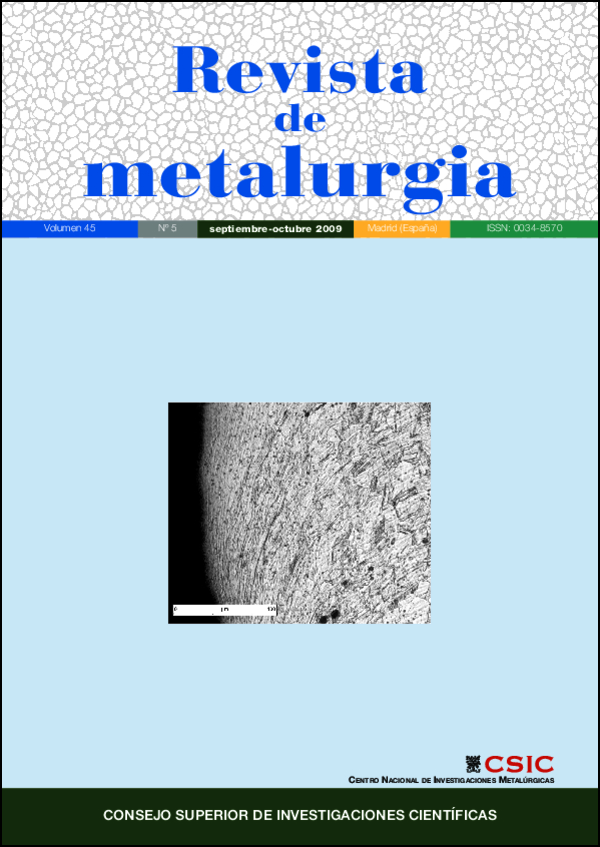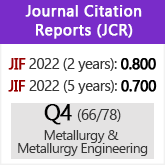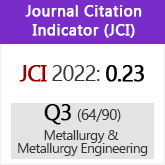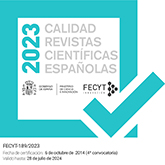Analysis of fluid flow in a stirred reverberatory furnace with different impellers, by physical and numerical modeling
DOI:
https://doi.org/10.3989/revmetalm.0906Keywords:
Aluminum refining, Turbulent multiphase flow, Mathematical modeling, Physical modelingAbstract
A fluid flow analysis and particle trajectory in a 5 t molten capacity scaled 1:2 model of a reverberatory furnace was performed using both physical and numerical simulation. The design of the system allowed studying the behavior of the liquid in a system agitated by impellers. The parameters studied were, rotating speed, shape and height of the impeller. The physical and numerical simulations were used to determine circulation and mixing times, fluid flow patterns and velocity profiles in the agitation and melting chambers. Using experimental data, it was possible to establish the interaction between turbulent flow and circulating solid particles. The original design of the reverberatory furnace was modified based on the physical and numerical simulation analysis. The new design showed an increased magnesium removal rate by means of a more efficient and faster mixing.
Downloads
References
[1] C. Martínez, Tesis de Maestría, CINVESTAV, 1998.
[2] S. L. Yeoh, G Papadakis y M. Yianneskis, Chem. Eng. Sci. 60 (2005) 2.293-2.302.
[3] C. Galleti, A.P. Aglianti y M. Yianneskis, Chem. Eng. Sci. 60 (2005) 2.317-2.331.
[4] L Nikiforaki, G Montante, K.C. Lee, M. Yian - neskis, Chem. Eng. Sci. 58 (2003) 2.937-2.949.
[5] Y. Murakami, T. Hirose, T. Yamato, H. Fujiwara y M. Ohshima, J. Chem. Eng. Jpn. 13 (1980) 318-323. doi:10.1252/jcej.13.318
[6] T. Nomura, T. Uchida y K. Takahashi, J. Chem. Eng. Jpn. 30 (1997) 875-879. doi:10.1252/jcej.30.875
[7] W.G. Yao, H. Soto, K Takahashi y K. Koyama, Chem. Eng. Sci. 52 (1997) 807-814. doi:10.1016/S0009-2509(96)00381-8
[8] A.A. Barresi. Chem. Eng. Sci. 53 (1998), pp. 3.031-3.040.
[9] A. Flores, C. Martinez, J.C. Escobedo, J.A. Toscano y A. Puente, Light Metals. (1999) 711-718.
[10] J.C. Escobedo, J.F. Hernandez, S. Escobedo, A. Flores y D.A. Cortes, Rev. Met. Madrid 39 (2003) 172-182.
[11] F. Barajas, Tesis de Maestría en Ing. Metalúrgica, Centro de Investigación y Estudios Avanzados del IPN, 2004.
[12] D.J. Lamberto, M.M. Alvarez y F.J. Muzzio, Chem. Eng. Sci. 54 (1999) 919-942. doi:10.1016/S0009-2509(98)00275-9
[13] B.E. Launder y D.B. Spalding, Comput. Method.Appl. Mech.Eng. 3 (1974) 269-289. doi:10.1016/0045-7825(74)90029-2
[14] R. I. Guthrie, Engineering in Process Metallurgy, Oxford University Press, EE.UU., 1992, pp. 174-175, 178.
[15] N.B. Reyes, Tesis Maestría en Ing. Metalúrgica, Centro de Investigación y Estudios Avanzados del IPN, Ramos Arizpe Coah. 2006.
[16] D. Mazundar, Tesis Doctoral, McGill Univ., Montreal, Canadá, 1985.
[17] Patent US2005/0035503 A1.
[18] Patent US2008/0023891 A1.
Downloads
Published
How to Cite
Issue
Section
License
Copyright (c) 2009 Consejo Superior de Investigaciones Científicas (CSIC)

This work is licensed under a Creative Commons Attribution 4.0 International License.
© CSIC. Manuscripts published in both the printed and online versions of this Journal are the property of Consejo Superior de Investigaciones Científicas, and quoting this source is a requirement for any partial or full reproduction.All contents of this electronic edition, except where otherwise noted, are distributed under a “Creative Commons Attribution 4.0 International” (CC BY 4.0) License. You may read here the basic information and the legal text of the license. The indication of the CC BY 4.0 License must be expressly stated in this way when necessary.
Self-archiving in repositories, personal webpages or similar, of any version other than the published by the Editor, is not allowed.


















